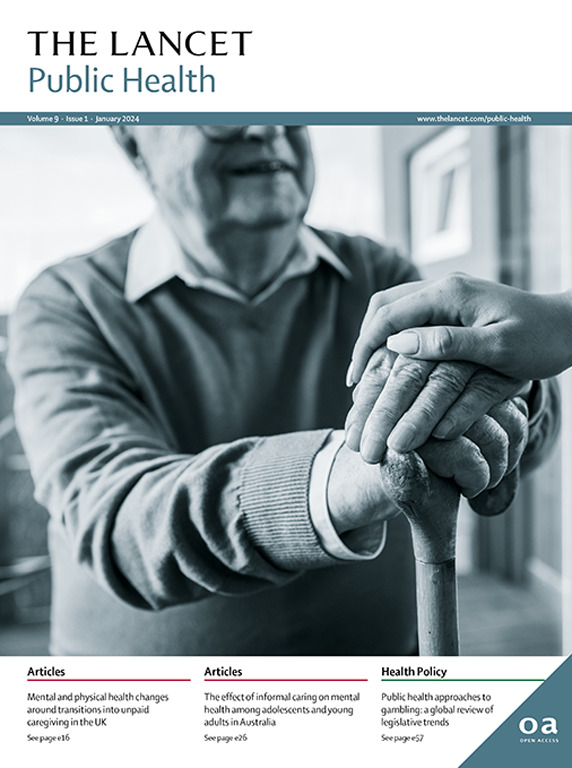青少年物质使用模式和随后的精神和行为障碍、物质使用和自杀行为风险:一项队列研究
IF 25.2
1区 医学
Q1 PUBLIC, ENVIRONMENTAL & OCCUPATIONAL HEALTH
引用次数: 0
摘要
背景:尽管对青少年药物使用的不同模式的了解越来越多,但它们与后来不良心理健康和药物使用结果的关系仍然知之甚少。我们的目的是确定青少年的物质使用模式,描述具有不同模式的青少年,并检验物质使用模式预测精神障碍、因酒精或药物使用而就诊以及自杀行为的假设。方法对68301名高中学生(平均年龄17.8岁[SD 0.99])进行校本调查,采用潜在类别分析方法识别药物使用模式。使用逻辑回归分析了个体、社会和环境健康相关因素对具有不同模式的青少年的特征。使用医院和处方登记数据评估因饮酒、吸毒、任何精神或行为障碍、自杀行为、饮食失调、焦虑或强迫症以及抑郁症而首次接触医院的患者,随访时间为2014年至2022年。使用Cox回归检查药物使用模式与结果之间的关联。我们确定了物质使用模式:仅酒精(48.8%)、频繁酗酒(23.3%)、实验性物质使用(16.3%)和早发性多种物质使用(11.6%)。在实验性药物使用组和早发性多重药物使用组中积累了不良的童年经历、经济劣势和较差的身心健康状况。值得注意的是,大多数研究结果的风险在实验性药物使用组和早发性多种药物使用组中始终较高。与纯酒精组相比,早发性多种物质使用组的风险最高,包括酒精导致的医院接触(风险比2.25 [95% CI 1.89 - 2.68])、药物导致的医院接触(风险比10.7[8.78 - 13.1])、任何精神或行为障碍或使用精神药物(风险比1.58[1.48 - 1.69])和自杀行为(风险比3.20[2.55 - 4.03])。令人惊讶的是,频繁酗酒组的任何精神或行为障碍的风险(0.83[0.77 - 0.89])都低于纯酒精组。在8年的随访中,实验组和早发性多种药物使用组的所有结果的风险都较高。高危物质使用的青少年在青年成年期面临不良精神和物质使用结果的风险增加,健康和社会不利因素往往集中在这一群体中。有针对性的预防工作应优先考虑这些易受伤害的年轻人。FundingTryg基础。本文章由计算机程序翻译,如有差异,请以英文原文为准。
Adolescent substance use patterns and subsequent risk of mental and behavioural disorders, substance use, and suicidal behaviour: a cohort study
Background
Despite growing knowledge of distinct patterns of substance use in adolescents, their associations with later adverse mental health and substance use outcomes remain poorly understood. We aimed to identify adolescent substance use patterns, describe adolescents with distinct patterns, and test the hypothesis that substance use patterns predict mental disorders, hospital contacts due to alcohol or drug use, and suicidal behaviour.Methods
We used a school-based survey of 68 301 adolescents (mean age 17·8 [SD 0·99]) in upper-secondary education, to identify substance use patterns using latent class analysis. Adolescents with distinct patterns were characterised by individual, social, and environmental health-related factors using logistic regression. First-time hospital contacts attributable to alcohol use, drug use, any mental or behavioural disorder, suicidal behaviour, eating disorder, anxiety or obsessive-compulsive disorder, and depression were assessed using hospital and prescription register data, with follow-up occurring from 2014 to 2022. Associations between substance use patterns and outcomes were examined using Cox regression.Findings
We identified the substance use patterns alcohol only (48·8%), frequent binge drinking (23·3%), experimental substance use (16·3%), and early-onset multiple substance use (11·6%). Adverse childhood experiences, economic disadvantages, and poor physical and mental health were accumulated in the experimental substance use and the early-onset multiple substance use groups. Notably, the risks of most studied outcomes were consistently higher in the experimental substance use and early-onset multiple substance use groups. Compared with the alcohol only group, the early-onset multiple substance use group had the highest risks, including alcohol-attributable hospital contacts (hazard ratio 2·25 [95% CI 1·89–2·68]), drug-attributable hospital contacts (10·7 [8·78–13·1]), any mental or behavioural disorder or use of psychotropic medication (1·58 [1·48–1·69]), and suicidal behaviour (3·20 [2·55–4·03]). Surprisingly, the frequent binge drinking group had a lower risk of any mental or behavioural disorder (0·83 [0·77–0·89) than the alcohol only group. The higher risk of all outcomes in the experimental and early-onset multiple substance use groups remained across the 8 years of follow-up.Interpretation
Adolescents with high-risk substance use face an increased risk of adverse mental and substance use outcomes in young adulthood, and health and social disadvantages tend to cluster within this group. Targeted preventive efforts should prioritise these vulnerable young people.Funding
Tryg Foundation.求助全文
通过发布文献求助,成功后即可免费获取论文全文。
去求助
来源期刊

Lancet Public Health
Medicine-Public Health, Environmental and Occupational Health
CiteScore
55.60
自引率
0.80%
发文量
305
审稿时长
8 weeks
期刊介绍:
The Lancet Public Health is committed to tackling the most pressing issues across all aspects of public health. We have a strong commitment to using science to improve health equity and social justice. In line with the values and vision of The Lancet, we take a broad and inclusive approach to public health and are interested in interdisciplinary research.
We publish a range of content types that can advance public health policies and outcomes. These include Articles, Review, Comment, and Correspondence. Learn more about the types of papers we publish.
 求助内容:
求助内容: 应助结果提醒方式:
应助结果提醒方式:


